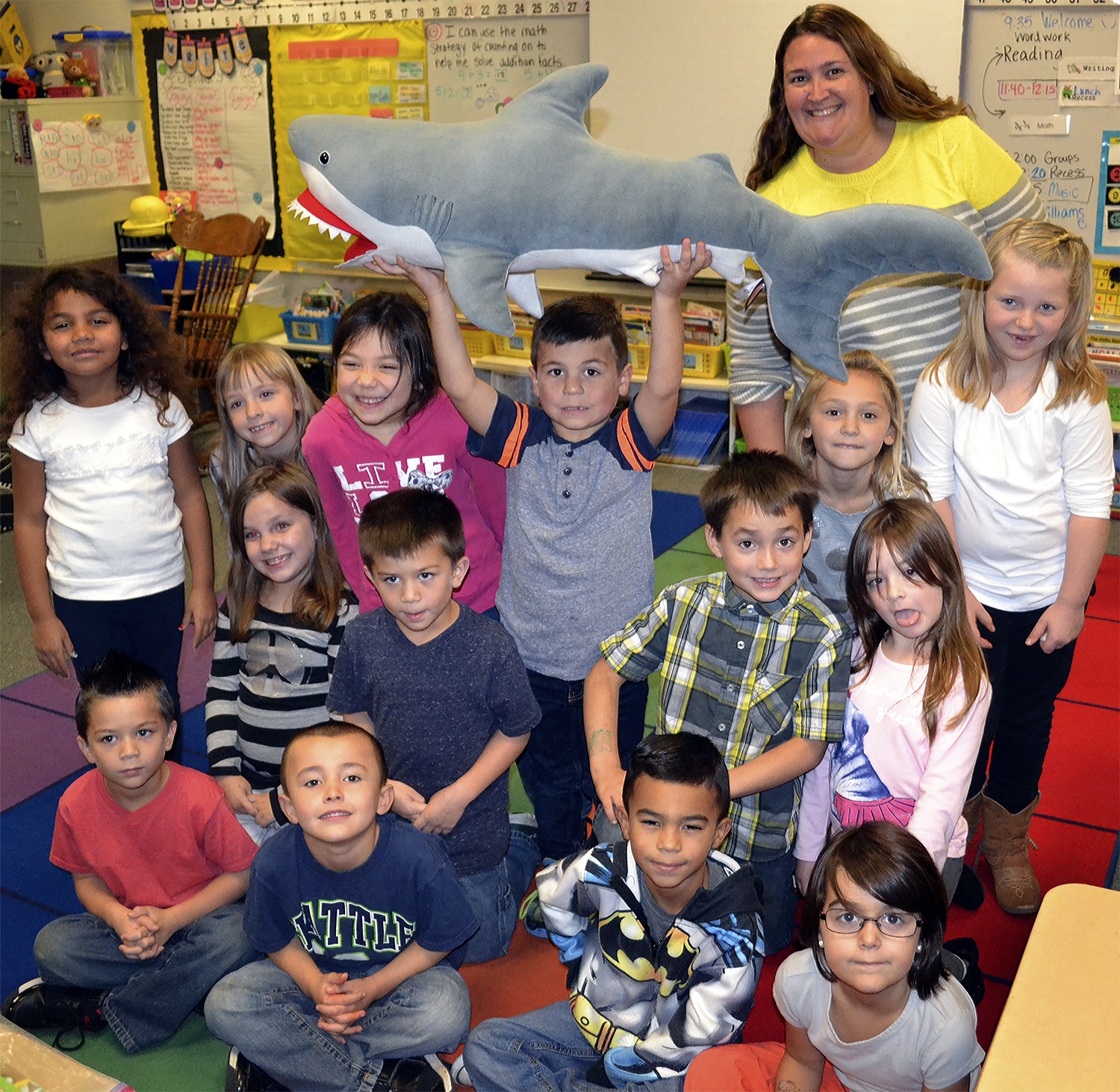MARYSVILLE – Shark Tank, Sharknado, Shark Week…
Those are all popular TV shows, but none are as popular at Shoultes Elementary as “Sharky,” which, by the way, is not a Halloween costume.
It is a prize, however. Any class that has the best attendance for a month is awarded the almost-lifesize fish. Brandi Holliday’s first-grade class was the initial winner.
Improving attendance is a key goal in the Marysville School District this year.
Vice Principal Jessica Conte said the school if having breakfast with parents of those who have good attendance, along with monthly award certificates and assemblies and a Wall of Fame. Those with too many unexcused absences get home visits.
Of the 478 students, 91 had chronic absences of 18 or more last year. The school’s attendance rate was 93 percent.
Part of the issue was cultural.
“Kids from Mexico took extended vacations to be with family,” Principal Lynn Heimsoth said.
The shark is also used as a tool to improve student behavior, another key issue for the district. After proper behavior is taught to the students, they receive “Sharky Slips” for repeating those positive behaviors. Students are then eligible for rewards.
About 160 students received behavioral referrals last year. Many had to do with socio-economic status, but even more had to do with adverse childhood experiences. Those include families dealing with separation, drugs, incarceration, etc. They found out that 36 students with three or more adverse experiences made up 64 percent of the problems.
“We’re trying to mitigate that” as best we can, said Heimsoth, adding 83 percent of the problem students are white boys. “That’s way out of proportion.”
The challenges are hard, but the staff celebrates successes.
“We have lots of little victories,” Conte said.
Heimsoth added, “We are all in this together.”
The schools has had some successes academically. Reading scores are up some and math scores up a lot for third- and fourth-graders.
“We’re looking for engagement, not just compliance,” — said of student learning.
The makeup of the student body is changing. The school has seen an increase of almost every minority.
“We ran out of apps for free and reduced rate lunches,” Heimsoth said.
School board President Pete Lundberg said, “Despite all the kids, and the problems, they’re learning.”
School board member Chris Nation said he is glad to see the school attack the problems head-on.
“You’ve made it a priority, and that’s commendable,” he said.
Heimsoth said using Facebook is helping the school communicate with parents, along with social media like Twitter and Instagram. Teachers are excited about technology and small-group learning.
Principal Stephanie Clark also talked about her school, Cedarcrest Middle School, at the school board meeting Oct. 17.
She said reading scores are up about 10 percent for seventh- and eighth-graders, while math scores are flat.
“We’re close to our goal of the state average” in reading, she said.
Scores also are up for special education and English language learners.
SPED teacher Michelle Dainard said those students who doing better because the teachers have learned the standards, and there is a common curriculum.
And the students love the hands-on approach.
“It’s the first time they can catch stuff on fire and not get in trouble,” Clark said, laughing.
PBIS is also working well at school, with positive discipline before the negative, 60 kids recently went to Western Washington University as part of a leadership class, and 50 percent of the students are on free or reduced lunch. Administrators and teachers are going to be studying a book on how high poverty students can become high performing students.
“Congratulations. You’re doing much better than last year,” school board member Bruce Larsen said.
During final comments, Nation said districts need to step up and provide behavioral counseling in all schools “to develop and enhance children.”
Also, Marysville Getchell student Connor Stickles talked to the board about the decline at that school. He said it worked better when there were four small learning communities.
“We were able to pass down our culture to freshman in advisory,” he said. “That inspired a community.”
He said without that mentorship program, “We can’t create those opportunities for students” to work together.
He said that is hurting academic performance. In 2011, graduation rate was 96.4 percent. Last year is was 83.7 percent.
Later in the meeting, Lundberg said a lot of people liked the small learning committees. But others have asked for one large campus previously. They are working on a solution that will “meet the needs of most kids. We don’t know what that will look like.”
The board is doing a yearlong internal study on the effectiveness and efficiency of the smaller high schools, district communications director Emily Wicks said.
The number of MG principals dropped from four to one due to budget reductions and running the campus more efficiently, she said.
“Any changes would involve a long community-input process, and we are far away from that,” Wicks said.



